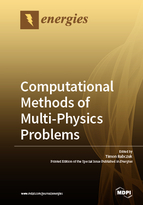Computational Methods of Multi-Physics Problems
A special issue of Energies (ISSN 1996-1073).
Deadline for manuscript submissions: closed (30 November 2018) | Viewed by 19825
Special Issue Editor
Interests: discontinuity; machine learning; multiscale modelling; isogeometric analysis
Special Issues, Collections and Topics in MDPI journals
Special Issue Information
Dear Colleagues,
We are inviting submissions to a Special Issue of Energies on the subject area of “Computational Methods for Multi-Physics Problems”. These problems might include hydraulic fracturing, piezoelectricity, flexoelectricity, modeling of energy harvesters or energy storage, or the modeling of batteries to name a few topics. The focus of manuscripts should be on computational modeling or new computational methods for such multi-physics problems. Computational modeling is a powerful tool and is complementary to experimental testing. Topics of interest for publication include, but are not limited to:
- Computational methods for moving boundary/interface problems;
- Phase field models;
- Meshfree and isogeometric formulations;
- Multiscale methods;
- Uncertainty analysis and uncertainty quantification;
- Verification and Validation;
- Optimization;
- Machine Learning approaches;
- Prediction of material properties;
- Nano-scale modeling (MD, DFT, etc.).
Prof. Dr. Timon Rabczuk
Guest Editor
Manuscript Submission Information
Manuscripts should be submitted online at www.mdpi.com by registering and logging in to this website. Once you are registered, click here to go to the submission form. Manuscripts can be submitted until the deadline. All submissions that pass pre-check are peer-reviewed. Accepted papers will be published continuously in the journal (as soon as accepted) and will be listed together on the special issue website. Research articles, review articles as well as short communications are invited. For planned papers, a title and short abstract (about 100 words) can be sent to the Editorial Office for announcement on this website.
Submitted manuscripts should not have been published previously, nor be under consideration for publication elsewhere (except conference proceedings papers). All manuscripts are thoroughly refereed through a single-blind peer-review process. A guide for authors and other relevant information for submission of manuscripts is available on the Instructions for Authors page. Energies is an international peer-reviewed open access semimonthly journal published by MDPI.
Please visit the Instructions for Authors page before submitting a manuscript. The Article Processing Charge (APC) for publication in this open access journal is 2600 CHF (Swiss Francs). Submitted papers should be well formatted and use good English. Authors may use MDPI's English editing service prior to publication or during author revisions.






